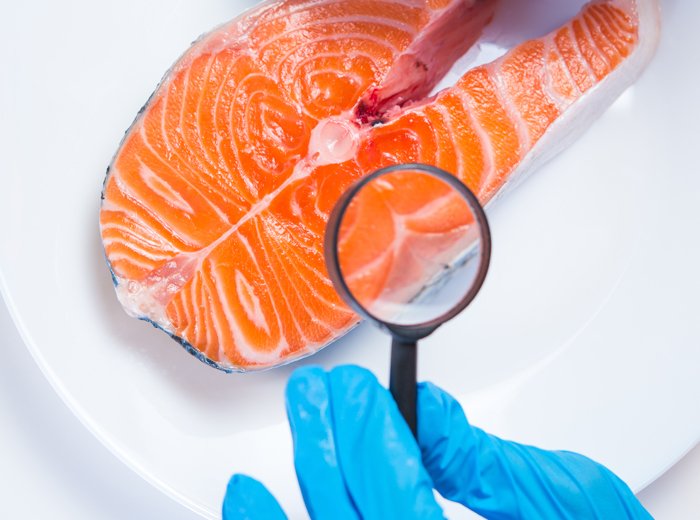Shelf-Life Evaluation for Food Products
1593 Views |

ปัจจุบันผลิตภัณฑ์ที่จะนำไปวางจำหน่ายต้องมีการบ่งชี้อายุของสินค้า ซึ่งต้องมีข้อมูลทางวิชาการสนับสนุน เพื่อรับรองอายุการเก็บรักษาของผลิตภัณฑ์อาหารที่ยังคงมีคุณภาพเป็นที่ยอมรับของผู้บริโภค และปลอดภัยตามเกณฑ์มาตรฐาน ปัจจุบันนี้การแข่งขันทางการค้าค่อนข้างสูง และมีผลิตภัณฑ์ใหม่ๆ เกิดขึ้นอยู่ตลอดเวลา
ด้วยเหตุนี้ การประเมินอายุการเก็บรักษาผลิตภัณฑ์ (Shelf Life Evaluation) จึงเป็นสิ่งจำเป็นต่อการรับรองคุณภาพของสินค้าก่อนออกสู่ตลาด
ลักษณะการเสื่อมเสียในผลิตภัณฑ์อาหาร แบ่งเป็น 4 ลักษณะ ได้แก่ การเสื่อมเสียทางกายภาพ การเสื่อมเสียทางเคมี การเสื่อมเสียทางจุลินทรีย์ และการเสื่อมเสียทางประสาทสัมผัส ตัวอย่าง
การเสื่อมเสียของผลิตภัณฑ์อาหารในแต่ละรูปแบบ
สิ่งที่ต้องพิจารณาในการประเมินอายุการเก็บรักษาผลิตภัณฑ์
1. การเตรียมตัวอย่างผลิตภัณฑ์
ตัวอย่างผลิตภัณฑ์ที่ใช้ในการทดสอบต้องเป็นแบบเดียวกันกับที่จะจำหน่ายจริง เช่น ปริมาณบรรจุจริง หรือภาชนะบรรจุจริง
2. การเลือกดัชนีคุณภาพ
ดัชนีคุณภาพที่จะใช้ในการประเมินอายุการเก็บรักษาผลิตภัณฑ์ต้องสามารถสะท้อนถึงลักษณะการ
เสื่อมเสีย และสามารถวัดค่าเป็นปริมาณได้
3. กำหนดความถี่ในการตรวจวัดดัชนีคุณภาพ
การตรวจติดตามจะต้องดำเนินการตามช่วงเวลาต่างๆ ที่กำหนดขึ้น เช่น ทุกวัน ทุก 3 วัน ทุกสัปดาห์ หรือทุกเดือนขึ้นอยู่กับชนิดของอาหาร
4. กำหนดระดับของดัชนีคุณภาพที่ยอมรับได้
การกำหนดระดับที่ยอมรับได้ส่วนมากจะอ้างอิงตามกฎหมายอาหารที่มีอยู่ หรือจะเป็นการกำหนดจากเกณฑ์มาตรฐานของผู้ผลิต
5. เลือกสภาวะในการเก็บรักษา โดยขึ้นอยู่กับความเหมาะสมของอาหารนั้น
- อุณภูมิแช่เย็น เหมาะสำหรับผลิตภัณฑ์ที่เสื่อมเสียทางด้านจุลินทรีย์ อย่างเช่น นม และน้ำผลไม้
- อุณหภูมิแบบบ่มเร่ง (เช่น 35 oC, 45 oC, 55 oC) สามารถนำข้อมูลมาคำนวณหาอุณหภูมิการเก็บรักษาที่เหมาะสม เช่น ผลิตภัณฑ์ที่วางจำหน่ายตามร้านสะดวกซื้อต่างๆ ที่อุณหภูมิห้องได้
- อุณหภูมิแบบแช่แข็ง เช่น ผลิตภัณฑ์อาหารแช่แข็ง และผลไม้แช่แข็ง เป็นต้น
การเปลี่ยนแปลงของอาหารอันเกิดจากการไม่ประเมินอายุการเก็บรักษาอาจส่งผลให้ผู้ผลิตอาหารสูญเสียรายได้ และส่งผลต่อชื่อเสียงด้านลบแก่องค์กร มากไปกว่านั้นยังส่งผลกระทบต่อสิ่งแวดล้อม และความยั่งยืนของโลกอีกด้วย เนื่องจากการผลิตอาหารอาศัยการรวมกันของวัตถุดิบหลากหลายชนิด ซึ่งวัตถุดิบแต่ละชนิดมีต้นทุนทางธรรมชาติ และการปล่อยก๊าซเรือนกระจกที่ส่งผลเสียต่อโลกของเราเช่นกัน รวมถึงก่อให้เกิดผลเสียต่อสุขภาพของผู้บริโภค และอาจร้ายแรงถึงขั้นเสียชีวิตได้
Currently, food products available in the market require the shelf life indicator supported by academic information. These credentials ensure the food product remains the good quality throughout its shelf-life according to the customer acceptability and following the food safety standards. Nowadays, trade competition is growing; they compete by launching new products to the market. Therefore, the shelf life evaluation is necessary for product quality certification before launching it to the market.
Food deterioration is classified into four characteristics: physical deterioration, chemical degradation, biological changes, and sensory changes.
Consideration of shelf life evaluation
1. Sample preparation
The product sample used for evaluation must be the same as the actual product selling in the market, such as the actual weight or volume and container.
2. Product criteria selection
The quality criteria used for evaluation must be related to the deterioration and can measure in numerical.
3. Determination of measurements frequency
Monitoring must be carried out at regular intervals to see when it begins to spoil, for example, every day, every 3 days, every week, or every month depending on the type of food.
4. Determination of the acceptable level
Most of the acceptable levels are based on food law or according to manufacturer benchmark.
5. Storage selection
The storage condition is based on the characteristics of food product
- Low temperature or cold storage conditions are suitable for product that spoils easily from microorganisms such as milk and juice.
- Accelerated storage conditions (35, 45, 55 oC) can provide data that is taken to calculated at the optimum temperature for food products storage. For example: products in convenience stores at room temperature.
- Frozen storage is used for frozen food and frozen fruit product.
Lack of shelf life evaluation change of food product without shelf life evaluation may affect the manufacturer in terms of lost revenue and negatively on the organization's reputation. Moreover, it also affects the environment and sustainability of the world. This was because food production applied a combination of several raw materials that has a cost and greenhouse gas emission, which harmed our planet. For this reason, it seriously affects the health of consumers and can be fatal.
By: Prachern Narkpun
Manager, Division of Microbiological Laboratory
National Food Institute (NFI)
prachern@nfi.or.th



